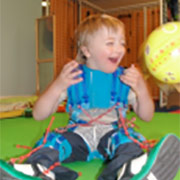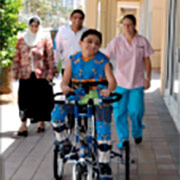Case Studies
Case 1 – Ben, from England
Age at Time of Evaluation: 6 years and 10 months
Diagnosis: Russell Silver Syndrome
History

Patient is a 6-year and 10 month-old boy who presents global developmental delay. He does not have a closed diagnosis and his medical team is currently investigating for a possible Russell Silver Syndrome. When he was six weeks old Ben stopped growing and since then they have been investigating the reason for his delays. His Mom reported an uncomplicated pregnancy and a normal birth at 39 weeks gestation. There was no record of any surgeries. Hip x-rays were negative for bilateral hip dislocation/subluxation.
Following evaluation it was determined that the patient was appropriate for and would benefit from intensive therapy to address his impairments. Recommended duration of treatment was 4 hours/day, 5 days/week for 4 weeks. The number of weeks was predetermined prior to arrival because the patient did not reside locally.
Patient lives with his Mom in England and this was their first trip to Fort Lauderdale for intensive therapy.
Evaluation
During the initial evaluation, patient's normal passive range of motion for all joints. His active range of motion was limited in the last 1/3 of the range for both upper and lower extremities secondary to diminished strength. He was able to perform modified independent transitions (supine/prone to sitting to standing), requiring occasional minimal assistance and verbal cuing. When transitioning from the floor into standing, he used a stationary object to pull himself up. He ambulated initially a few steps independently using a wide base of support, minimal knee flexion and a lack of heel strike with each step. Evaluation of his posture indicated a mild scoliosis destroconvex and bilateral valgus positioning of his feet. The Gross Motor Function Measure (GMFM) 88, an assessment of gross motor function, was performed.
Impairment List:
- Static and Dynamic balance
- Strength in core and bilateral upper and lower extremities
- Postural deviations
- Mobility
Short Term Therapy Goals:
- Patient will give 10 steps independently carrying a large object demonstrating good balance
- Patient will hop with both feet 3 times keeping his balance
- Patient will walk for 5 minutes on the treadmill with the bungee cords support demonstrating correct biomechanics
Treatment
Patient received intensive physical therapy 4 hours/day, 5 days/week for 4 weeks. Patient began each session with a warm-up that included brushing, joint compression, ROM/stretching, sit-ups, bicycles and bridging. Exercises were completed with minimum assistance from the therapist. Patient completed transitional activities with minimum assistance. Following transitional activities, the PediaSuit was donned. The patient then completed postural, balance, walking, strengthening, and coordination activities. The patient also utilized the ability exercise unit and the spider cage daily to perform balance (static and dynamic), coordination, mobility and strengthening.
Discharge and Progress Summary
Upon completion of his first session of intensive therapy, he was a far more active and independent child. His active range of motion was within functional limits for all joints as a result of an increase in his overall strength. He was performed transitions (floor to standing) with increased speed, improved balance and increased independence. He was able to sit and stand up from a bench independently and without the use of his hands for support. His dynamic balance improved significantly resulting in less falls and an increase in his ability to multi-task (attend to someone speaking without falling, carrying objects and looking around his environment while walking). He walked with confidence in his abilities and demonstrated a better gait pattern.
Ben's base of support narrowed during ambulation. He demonstrated improved hip and knee flexion during advancement of each lower extremity and was demonstrating an appropriate heel to toe gait pattern.
The Gross Motor Function Measure (GMFM) 88 was completed again and his score improved by 20.59 %.
The patient's Mom opted to purchase a PediaSuit and were provided with training for the donning and doffing of the suit. The Mom was also provided with education and a home exercise program so she could continue his stretching program and exercises once they returned home.
We are more than pleased with the results we have seen in our intensive therapy program. This case is just one example of the improvements we see daily.
Case 2 – Undisclosed name
Age at Time of Evaluation: 11 years and 11 months
Diagnosis: Cerebral Palsy (CP)
History

Eleven years and eleven month old male diagnosed with CP presented to the clinic for evaluation and treatment. Patient's family reported an uncomplicated pregnancy with a premature birth via vaginal delivery. Hip x-rays were negative for bilateral hip dislocation/subluxation. Patient's vision is slightly impaired and required glasses and large words to read.
Patient attends typical school and relies on family members for all mobility tasks. Patient received electro-therapy on and off throughout the years, but is not currently receiving any therapy. He owns a walker with a seat and a standard walker. He was previously wearing orthotic boots with poor dorsiflexion and medial/lateral support. Patient was not taking any medication.
Family/Patient's Goals:
- Walking
- Sitting more upright
- Increased mobility
Evaluation
Patient present with cognitive abilities that are within normal limits (WNL) for his age. Patient communicates verbally, and has auditory skills WNL. Patient requires glasses and large font for reading. Patient presented with bilateral clonus and poor/delayed righting and protective responses. Patient presented with left scoliosis. Patientt presented with poor protective and righting reflexes.
Impairment List:
- Strength in core and bilateral upper and lower extremities
- ROM in bilateral dorsiflexors
- Strong clonus present with bilateral dorsiflexion
- Balance in sitting, quadruped and standing
- Ability to perform transitions
- Overall mobility
Following evaluation it was determined that the patient was appropriate for and would benefit from intensive therapy to address his impairments. Recommended duration of treatment was 4 hours/day, 5 days/week for 5 weeks. The number of weeks was predetermined prior to arrival because the patient did not reside locally.
Short Term Therapy Goals:
- Patient will maintain quadruped for 30+ seconds independently
- Patient will demonstrate 3/5 strength in bilateral hamstrings
- Patient will demonstrate good core control in sitting
Treatment
Patient received intensive physical therapy 4 hours/day, 5 days/week for 5 weeks. He was fitted for and received bilateral AFO's to replace his orthotic boots. The AFO's provided immediate improvement in tone control and ROM. Patient began each session with a warm-up that included brushing, joint compression, ROM/stretching, sit-ups, side sit-ups, trunk extension, bicycles and bridging. Exercises were completed with min assist from the therapist. He completed rolling and transitional activities with min assist. Following transitional activities, the PediaSuit was donned. The patient then completed postural, balance, standing, walking, strengthening, and coordination activities. He also utilized the ability exercise unit and the spider cage daily to perform balance, strengthening, coordination and standing activities.
As the patient's functional skills and strength improved, his activities were progressed to more difficult activities. The more advance activities included transitions into sitting, tall kneeling and quadruped, stabilization exercises, independent body weight resistance activities, sit to stand with upper extremity assist, body weight supported treadmill training, postural righting in standing and tall kneeling and prolonged weight bearing in tall kneeling and supported standing.
Discharge and Progress Summary
Following 5 weeks of intensive therapy, numerous improvements were noted in the patient's strength, transitional ability, postural control and mobility. He was able to attain and maintain quadruped for 30+ seconds independently and demonstrate good core control in sitting as evidence by maintaining sitting with moderate perturbations. Patient's hamstring strength increased to 3/5 bilaterally. Upon discharge, he was able to attain quadruped independently and initiate a reciprocal crawling pattern with his arms and legs; complete table top activities in tall kneeling with the support of one arm; and ride a modified bicycle independently. He is continuing to make exceptional progress towards further increasing his independent mobility.
The patient's parents opted to purchase a PediaSuit and were provided with training for the donning and doffing of the suit. The parents were provided with education and a home exercise program so they could continue his stretching program and exercises once they returned home.
